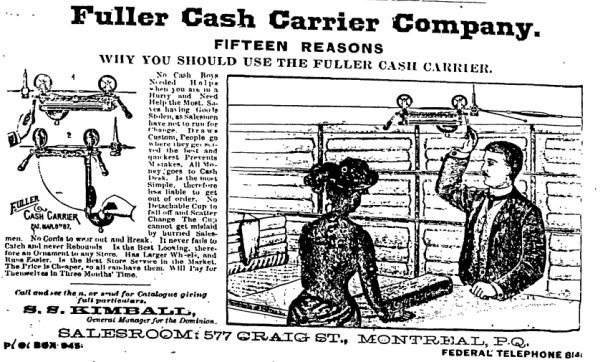
This illustration is is from an envelope franked 30 December 1893. The carrier runs on a single wire propelled somehow by a cord with two handles (one for each direction?). The cup is permanently attached to the carriage and hinges down for inserting or removing money. The same illustration appeared in Scientific American (15 March 1890), p. 165.
"This car runs on a horizontal wire, between salesman and cashier. The cup to hold money is part of the car." Boston Massachusetts Charitable Mechanic Association. Exhibition (date unknown)
There was a court case in 1891 brought by Lamsons but their claim was dismissed.
One store known to have a Fuller system was Bussell and Weston of Augusta ME in 1891.
The company was listed as owned by Lamsons but not in active business in 1906. Listing statements of the New York Stock Exchange, vol. 8, 1906, p.4

The company had a Canadian office in Montreal. Advertisment from Canadian Journal of Fabrics, Dec. 1890.
An item in The Independent (New York), 3 April 1890, has a section "Prices and Terms." The price guaranteed up to 1 October 1890 was $30 per car including installation or $25 for parties who up their own systems. Fullers could only put up systems at places where they had agents but would provide directions and photographs so that "any plumber or person accustomed to stretching wires" could readily put them up. They also offered systems on three years' lease at $10 per car. They claim that a number of Lamson systems had been replaced by Fuller carriers and "in every instance it has been pronounced superior to the Lamson".
The Scientific American article described the system as follows:
" The cup is permanently attached to the car, and consequently not liable to be misplaced or lost, while the car requires but a slight effort to propel it along the wire. The wire at either end, next the stop, is increased in thickness, this portion being approached by a slight bevel, and as the car wheels ride up this portion of the wire toward the stop a spring brake on the car engages the periphery of the wheels. There is also a rubber buffer on the stop by which, in connection with the action of the brake, the car is brought to a standstill without noise or jar, even if its motion had ben excessive. The car never fails to catch and never rebounds, while it requires but a slight turning of the handle at either end to release the brake when the car is sent on its way."
(In fact, the wire itself is not thicker at each end but it passes through a tube which the car's leading wheel engages with. The wire is folded back on itself though a hole and twisted....this secures the wire and also tensions it. The terminal has a hook attached so it could be hung from the ceiling or a low shop fixture. Thomas Macey)


